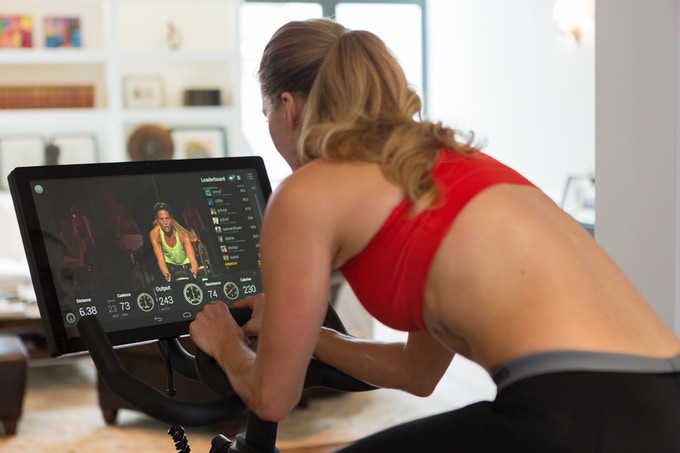What is Peloton bike, and how does it work?
Aside from the lavish marketing material and the quibble over the word 'Peloton' - who are these guys?

Image: Peloton Kickstarter page

'Ok Peloton, let's do this!' - if you've not heard the sweaty call from a spin bike yet, you've been spending more time riding your bike than watching television, which is a testament to your dedication.
One Peloton was founded in 2012, and began selling the bikes in 2014 after a successful Kickstarter campaign. According to Forbes, in January 2019 it had 1 million subscribers and a 96 per cent retention rate.
The American company has more recently burst onto our UK screens, and Twitter feeds - for an assortment of good and not so good reasons.
>>> Spin classes: cycling inspired fitness or a road to ruined legs?
The cycling community became particularly aware of Peloton when they issued a cease and desist letter to YouTuber Shane Miller for - you guessed it, his use of the word 'peloton'. Not the best entry into the cycling community.
The latest race content, interviews, features, reviews and expert buying guides, direct to your inbox!
Peloton also gained a bit more, perhaps unwanted, but free airtime when Twitter user Clue Heywood poked a little fun at the high end marketing strategy, which perhaps gives us an inkling into the target market being encouraged to join this sacred peloton.
However, the app (and corresponding bike) has been racking up the column inches for more positive reasons across mainstream press.
Men's Health listed it as 'the best cardio machine', Forbes proclaimed the bike 'one of the great fitness success stories of recent years' and the Huffpost said: "the gift of a Peloton bike is truly the gift of better health (and a lot more sweat)."
>>> Indoor cycling training apps compared
So, cyclists remain unconvinced, the mainstream press loves it. But what is it all about?
What is the Peloton Digital app?
https://www.youtube.com/watch?v=VmvGmLCdSXA
The app works with iPad, iPhone or Android. Users can join over 14 live classes a day, led by Peloton's own instructors, or guests.
If a live class isn't taking place at a time that suits you, you can watch and follow an archived session, the library currently contains over 12,000 workout videos.
As the name would suggest, it started out with a focus on cycling, and most classes are on the bike. However, the company has since delved into the likes of running and yoga classes too.
How much does it cost?
The app costs $19.49 (£14.92) a month and is available for iPhone and Android.
The accompanying Peloton spin bike costs £1990 - that's the 'basic package'. The 'works package' with shoes, a mat, weights, headphones and heart rate monitor costs £2199. You can also opt to pay on finance.
The bike comes with a waterproof touchscreen which allows you to see the coach leading the class, shows your data on the screen alongside that of other users, slots you into a leaderboard and allows the coach to interact with you from the comfort of your home (as you melt into a puddle of sweat).
The machine uses a belt drive, to ensure it's super quiet, is highly adjustable, compatible with LOOK Delta pedals. And a handy cage at the back to store your hand weights....
Do you need the bike to use the app?
No.
If you buy the bike, you'll have the benefit of interactivity with the coach and other users. If you have the app alone, you can still follow along with the classes.

The instructors will refer to resistance units and cadence. The latter you'll get as long as you're using a speed/cadence sensor or power meter - the former is specific to the bike, of course you can click up the gears on your own bike but it won't be quite so accurate to the intended demands.
Do the sessions actually suit cyclists?
Many of the classes will follow the format of a traditional spin class, which means lots of out the saddle pedalling, and the additional weighs implies there will be some non-cycling specific work in there. All of that is pretty good for your core, and would boost all-round fitness - but it's not the same as cycling.
However, Peloton has enlisted the services of former Garmin-Sharp rider Christian Vande Velde, and ex-BMC pro and Lance Armstrong domestique, George Hincapie. From them, you'll find sessions that are very much tailored to traditional cycling, such as a 30/30 workout designed to build anaerobic threshold. Of course, such sessions are also available on the traditional big three: Zwift, TrainerRoad and The Sufferfest.

Thank you for reading 20 articles this month* Join now for unlimited access
Enjoy your first month for just £1 / $1 / €1
*Read 5 free articles per month without a subscription

Join now for unlimited access
Try first month for just £1 / $1 / €1
Michelle Arthurs-Brennan the Editor of Cycling Weekly website. An NCTJ qualified traditional journalist by trade, Michelle began her career working for local newspapers. She's worked within the cycling industry since 2012, and joined the Cycling Weekly team in 2017, having previously been Editor at Total Women's Cycling. Prior to welcoming her first daughter in 2022, Michelle raced on the road, track, and in time trials, and still rides as much as she can - albeit a fair proportion indoors, for now.
Michelle is on maternity leave from April 2025 until spring 2026.
